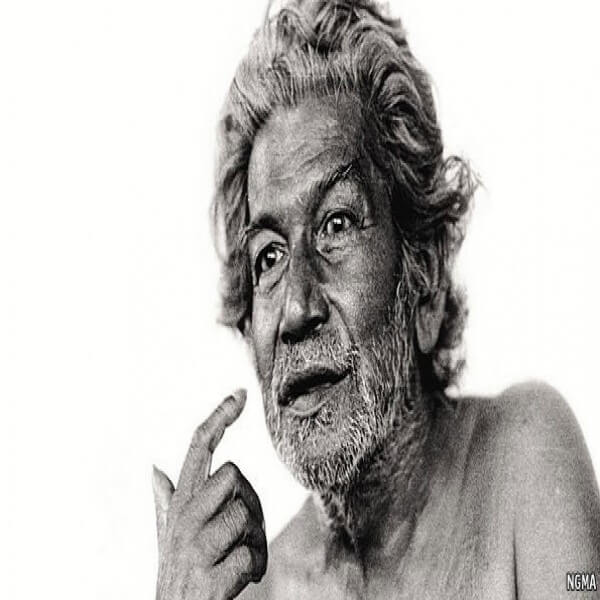Ramkinkar Baij
ABOUT
1970 Padma Bhushan, Government of India
Painter | Sculptor | India
Born in 1906
Died in 1980

Ramkinkar Baij was the earliest Indian artist to experiment with abstract sculptural forms. His oil on canvas paintings have a singular experimenting quality going beyond its time, unregimented by dogmas and with only one commitment - to be unstintingly creative. Born in Bankura Ramkinkar Baij studied at the Kala Bhavan, Vishwa Bharati University, Santiniketan in 1925. Trained by two European sculptors, one of whom was a disciple of Bourdelle, who were on a visit to Santiniketan on an invitation by Tagore, his style was still uniquely his own. Groomed by his mentors, Nandalal Bose and Tagore, the clay modeler turned artist. Working at a time when traditional art was transitioning to modern art, Baij's work proved to be crucial to Indian art history. Nature and Baij's own folk background turned out to be the crucial influences in the formation of his own style. Later, he headed the Department of Sculpture at the Kala Bhavan. He believed that it is only momentum that creates tension in a work of art. His work is characterized by a tremendous energy; his art is joyous, vital and reaching out to light. It is earthy and dynamic while showing a surging movement or growth. His path-breaking work in sculpture has been both acknowledged and respected, first in Santiniketan, then across the country, and internationally as well. His sand and pebble sculptures are noted for a typical, lyrical, metrical sensuality, which has an amazing oneness with nature. Indian sculpture, hitherto limited to academic naturalism, was transformed by this artist. He integrated elements of Santhal tribal art and life into his own work and enhanced them by an understanding of Western expressionism that was gleaned from books at the library of the Kala Bhavan. Although primarily known for his expressionistic sculpture, he was a gifted painter. This sense of rhythm that his sculpture is noted for is manifest brilliantly in his watercolors. The fluidity of this medium lent itself to his style. His works in the Kalighat tradition interconnected with Cubism to achieve a peculiarly personal idiom. Both his sculpture and his paintings are unprompted and bold. A retrospective of his works was held at the National Gallery of Art, New Delhi in 1990. His works are in the permanent collection of the National Gallery of Modern Art, New Delhi and in several private and public collections. EDUCATION: • 1925-29 Diploma in Fine Arts, Kala Bhavan, Visva-Bharati University, Santiniketan • 1934 Joined as Faculty, Kala Bhavan, Visva-Bharati University, Santiniketan EXHIBITIONS: Posthumous Exhibitions at • 2013 'The Naked and the Nude: The Body in Indian Modern Art', Delhi Art Gallery, New Delhi • 2012 'Gallery Collection', Vadehra Art Gallery, New Delhi • 2012 'Ramkinkar Baij: A Retrospective', Lalit Kala Akademi, New Delhi • 2011 'Ethos V: Indian Art Through the Lens of History (1900 to 1980), Indigo Blue Art, Singapore • 2011 ‘Manifestations VI', Delhi Art Gallery, New Delhi • 2011 ‘Manifestations V', Delhi Art Gallery, New Delhi • 2011 'Time Unfolded', Kiran Nadar Museum of Art (KNMA), New Delhi • 2010 ‘Manifestations IV', Delhi Art Gallery, New Delhi • 2008 'Moderns', Royal Cultural Centre, Amman, Jordan organized by Lalit Kala Akademi, New Delhi in collaboration with Embassy of India, Amman, Jordan • 2008 'Santhal Family: Positions Around an Indian Sculpture', in association with Bodhi Art, and supported by the British Council, Kunststiftung NRW and the Provence of Antwerp at Museum of Contemporary Art Antwerp (MuKHA), Belgium • 2005 ‘Manifestations III', Delhi Art Gallery, New Delhi • 2004 ‘Manifestations II', Delhi Art Gallery, New Delhi • 2003 ‘Manifestations', Delhi Art Gallery, New Delhi • 1997 'Santiniketan: The making of a Contextual Modernism', National Gallery of Modern Art (NGMA), New Delhi • 1995 'Man and NAture: Reflections on Six Artists', organized by Indian National Trust for Art and Cultural Heritage (INTACH) and National Gallery of Modern Art (NGMA), New Delhi • 1990 'Retrospective', National Gallery of Modern Art (NGMA), New Delhi SOLO EXHIBITIONS: • 1972 Birla Academy of Art & Culture, Kolkata • 1960-61,78 Visvabharati University, Santiniketan • 1960 'Paintings,Sketches & Sculptures', Calcutta Arts Council, Kolkata • 1942-47 New Delhi GROUP EXHIITONS • 1951 Calcutta Group Exhibition, Kolkata • 1950,51 Salon de Realities Nouvelle, Paris JOINT EXHIBITIONS • 1944 With Binod Behari Mukherjee at Massay Hall, New Delhi AWARDS: • 1979 Doctor of Letters Award from Visva-Bharati University,Santiniketan • 1977 Deshi Uttam Award by Viswa Bharti, Santiniketan • 1970 Padma Bhushan, Government of India • 1955 Government of India invited him to make Yaksha and Yakshi Sculpture for Reserve Bank of India (RBI), New Delhi • 1945 Government of Nepal invited him to make Buddhist Sculptures